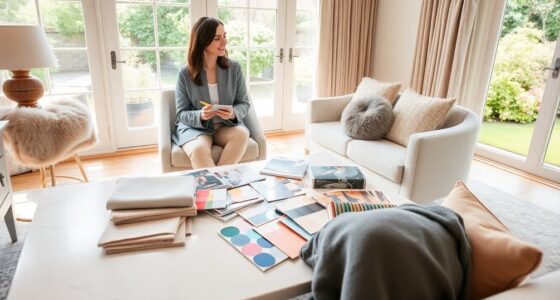In the world of interior design, your journey reflects creativity, challenges, and effective client engagement strategies. You'll discover how early influences shaped your career, the importance of education and real-world experience, and the daily routines that foster productivity. Learn how engaging clients through workshops and visual communication enhances the design process. As you navigate personal growth and continuous learning, you'll uncover insights that can elevate your craft and help you succeed in this dynamic industry.
Key Takeaways
- A strong foundation in design is essential, with real-world experience bridging the gap between theory and practice for new graduates.
- Engaging clients through interactive workshops enhances collaboration and communication, fostering trust and satisfaction throughout the design process.
- Time management is crucial for interior designers to balance work responsibilities with family commitments while maintaining productivity and creativity.
- Continuous learning through workshops and collaboration with industry professionals is vital for staying relevant and refining design skills.
- Personal experiences and unique perspectives significantly contribute to innovative design solutions, enriching the overall creative process.
Background and Career Journey
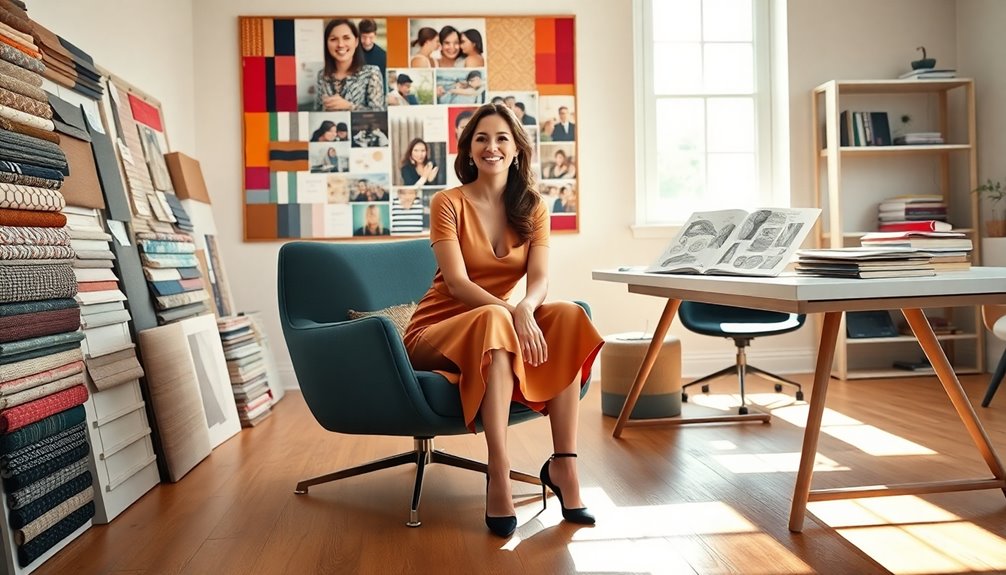
Growing up in a family of architects, you might say the seeds of creativity were sown early for our featured interior designer.
With over 20 years of experience in the design field, they've worked internationally in Scotland, Canada, and the United States. Inspired by their grandfather and father, both architects, they found their passion for design blossoming from a young age.
They rated their educational preparation as an 8 out of 10, recognizing the impact of upbringing and influential figures on their journey.
The first four years presented a steep learning curve, where office tasks focused more on documentation than client interaction.
This designer believes that mature age students bring rich life experiences that deepen their understanding of the field, enhancing their growth as an interior designer.
Education and Professional Experience
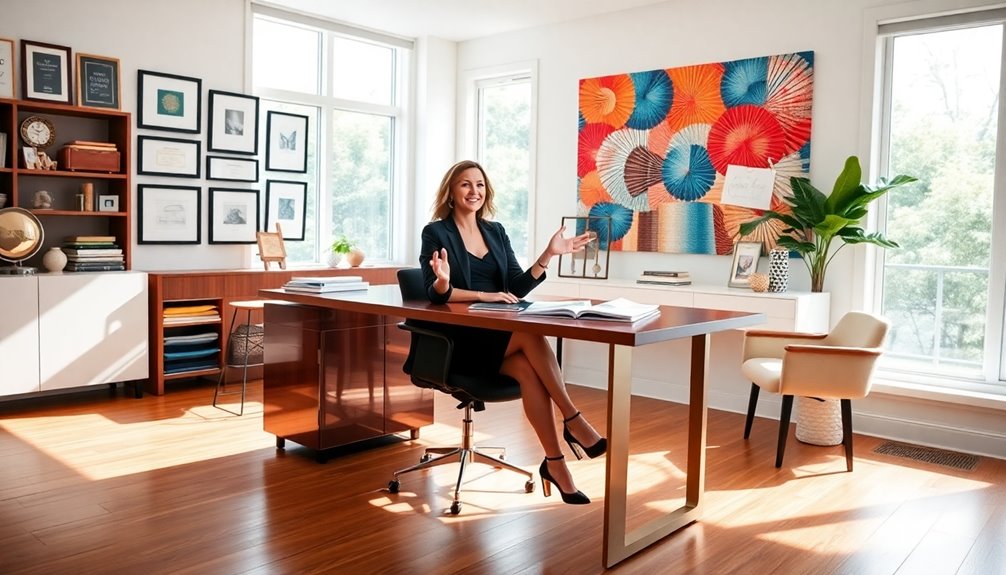
Having established a solid foundation in their early career, the designer reflects on their educational journey and professional experiences that shaped their expertise.
They rate their education preparation as an 8 out of 10, acknowledging strong foundational knowledge while recognizing areas for improvement.
Mature students often benefit more from this education due to their life experiences, enriching their learning process.
However, new graduates face a steep learning curve, shifting from theoretical studies to practical applications.
The designer emphasizes significant differences between university coursework and real-world demands, particularly in pressure and deadline management.
Many graduates enter the industry lacking practical knowledge, highlighting the importance of bridging this gap through internships and real-life projects for successful career development.
Daily Routine and Work Style

As the sun rises, the designer kicks off their day at 5:00 AM with invigorating outdoor exercise, which sharpens their focus for the challenges ahead.
A well-structured daily routine is crucial to their success. Each morning, they review their diary for meetings and create a task list.
Here's how they organize their workflow:
- Tackle complex tasks in the morning when energy is high.
- Reserve collaborative tasks for the afternoon to optimize productivity.
- Stay active in the office to combat afternoon fatigue.
Establishing these morning rituals sets a positive tone for the day and guarantees a productive workflow. Regular cleaning helps maintain a tidy environment, which promotes better sleep quality and empowers the designer to meet the demands of their dynamic role effectively.
Design Process and Client Engagement
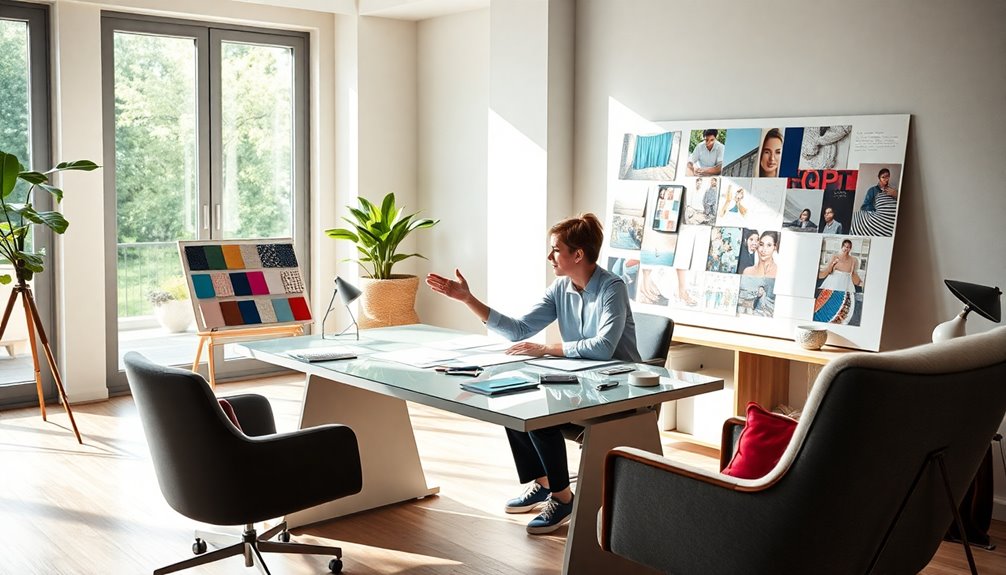
When you start a design project, engaging with clients through interactive workshops can be a game changer.
By focusing on conceptual design and using visual communication techniques, you can create a shared vision that resonates with everyone involved.
This collaborative approach not only enhances client satisfaction but also enriches the overall design process. Additionally, incorporating local craftsmanship into your designs can further personalize the experience and connect clients to the unique aesthetics of the region.
Conceptual Design Approach
While exploring the conceptual design approach, you'll find that professional interior designers prioritize big picture thinking over meticulous documentation. This method emphasizes collaboration, ensuring your insights shape the project's vision.
Here are three key elements of the conceptual design process:
- Client Insights: Workshops gather your needs, allowing the designer to curate ideas that resonate with you.
- Visual Aids: Tools like sketches and mood boards help communicate concepts clearly, ensuring you and the designer align on the vision.
- Collaborative Moments: Engaging together throughout the process fosters a strong relationship and enhances your satisfaction as you visualize your space in innovative ways.
Ultimately, the conceptual design approach enriches your experience, making it both enjoyable and effective. Additionally, this process often incorporates mood board creation, which serves as a visual representation of your design preferences and aspirations.
Client Interaction Workshops
Three key components define client interaction workshops in the design process: collaboration, communication, and creativity. Conducting these workshops allows you to gather valuable insights directly from your clients, fostering a collaborative environment.
Using visual aids like freehand drawings and mood boards helps articulate ideas, ensuring everyone shares a clear understanding of project goals. These workshops encourage problem solving by curating information into meaningful formats, making it easier for clients to grasp design concepts and provide effective feedback.
Engaging clients through these sessions generates excitement and trust, enhancing their overall experience and investment in the project. By emphasizing big-picture thinking, you align your vision with your client's desires, promoting creativity and innovation in the design process. Additionally, incorporating effective preparation maximizes the outcomes of these workshops, ensuring all parties are aligned from the outset.
Visual Communication Techniques
How can effective visual communication techniques elevate the design process and strengthen client engagement? These techniques are essential for bridging the gap between your creative vision and the client's expectations.
Consider these key strategies:
- Interactive Workshops: Engage clients in workshops to gather insights, ensuring your designs align with their needs from the start.
- Visual Aids: Use sketches and mood boards to articulate design concepts clearly, promoting a shared understanding between you and your clients.
- Freehand Drawing: Employ freehand drawings to convey big-picture ideas, helping clients visualize the overall concept before diving into specifics.
Additionally, incorporating natural elements into your designs can enhance tranquility and create a more inviting space for clients.
Personal Growth and Challenges
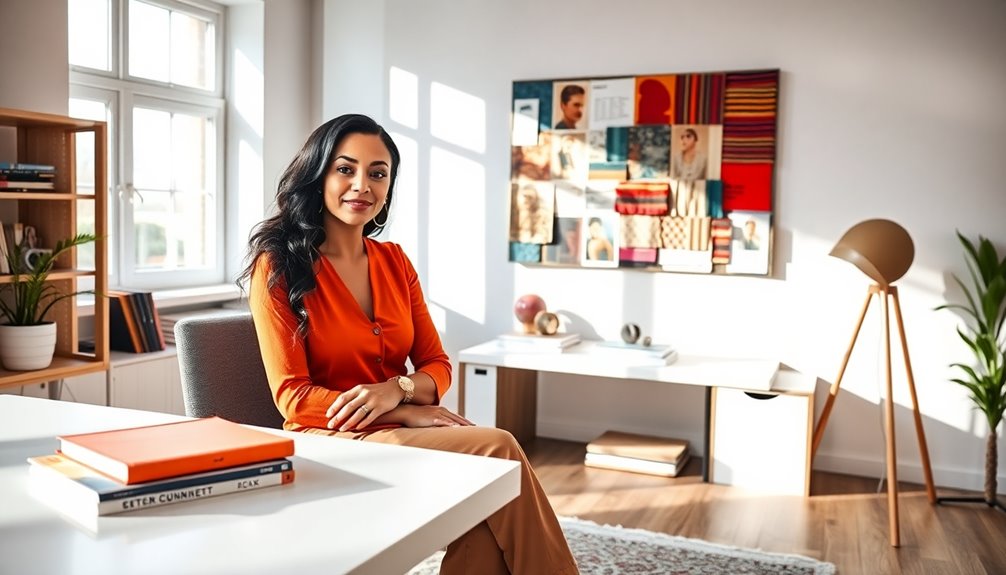
As an interior designer, you'll likely face challenges with time management while juggling work and family. Staying relevant in this fast-paced industry means committing to continuous learning and growth, even when feelings of inadequacy creep in. Embracing personal development strategies can help you navigate these challenges and foster resilience in your career.
Time Management Struggles
While balancing work commitments and family life, many interior designers face significant time management struggles that can hinder personal growth.
To navigate these challenges effectively, consider the following strategies:
- Prioritize Tasks: Organize your day based on urgency and energy levels. Tackle complex tasks in the morning when your mind is fresh.
- Establish a Routine: Start your day early, around 5:00 AM, to create a structured schedule that accommodates both work and family commitments.
- Engage in Morning Activities: Incorporate physical activity outdoors to mentally prepare and set a productive tone for the day. Additionally, creating a calm environment through decluttering can enhance focus and productivity throughout your day.
Continuous Learning Importance
Balancing your responsibilities as an interior designer often means juggling time constraints, but carving out space for continuous learning is essential for your growth.
Staying relevant in this rapidly evolving industry requires you to adapt to new trends, technologies, and client expectations. Engaging in workshops and courses can enhance your skills and broaden your knowledge base, leading to more innovative designs.
Exposure to diverse perspectives, whether through industry boards or collaboration with peers, enriches your problem-solving and creativity. Effective time management helps you balance professional growth with personal life, allowing you to pursue learning opportunities without compromising family commitments.
Additionally, traveling to different cultures provides invaluable insights, inspiring you to create unique, tailored spaces for your clients. Hydration is crucial for maintaining optimal brain function, which can enhance your creative thinking and overall productivity in the design process.
Unique Perspective Challenges
Maneuvering the design world often means confronting unique perspective challenges that can spur personal growth.
You'll likely face issues like time management, balancing professional duties with family life, and feelings of inadequacy when comparing yourself to talented peers.
However, embracing your unique perspective can be your greatest asset.
To navigate these challenges, consider:
- Continuous Learning: Stay updated with industry trends to avoid stagnation.
- Professional Engagement: Join boards like the Committee for Adelaide for valuable insights and growth opportunities.
- Supportive Culture: Foster a workplace that encourages trust and flexibility, balancing productivity with personal satisfaction.
These strategies not only enhance your skills but also promote a fulfilling career in interior design, especially when you leverage AI analytics to track your progress and refine your approach.
Client Engagement Strategies

How can you guarantee a successful collaboration with your clients? One effective approach is to implement client engagement strategies that involve interactive workshops. These sessions help you gather valuable insights, ensuring your final designs align with client expectations.
During presentations, utilize visual aids to clearly articulate your design concepts, fostering a shared understanding. Building trust throughout the design process enhances satisfaction and promotes collaboration.
Regularly soliciting feedback not only strengthens relationships but also allows for adjustments that reflect client preferences. Additionally, emphasizing your unique skills in styling and project management can greatly boost client engagement and showcase the value of your services. Implementing sustainable materials in your designs can also resonate with environmentally conscious clients, enhancing their engagement.
Balancing Creativity and Practicality

Successful client engagement lays the groundwork for a harmonious design process, and that harmony hinges on blending creativity with practicality.
You can effectively balance these two elements by focusing on:
- Interactive Workshops: Engaging clients in workshops helps you gather insights, aligning creative ideas with their practical needs.
- Visual Aids: Using visual tools enhances communication, allowing clients to see how your innovative concepts meet functional requirements.
- Time Management: Allocating time wisely guarantees you dedicate enough space for brainstorming while addressing project execution's practical aspects.
Insights on Continuous Learning

While the world of interior design constantly evolves, staying relevant requires a commitment to continuous learning. You'll find that engaging in workshops and interactive sessions with clients helps gather insights and refine your skills based on real-world feedback.
In your first four years in the profession, you'll face a steep learning curve, making ongoing education and mentorship vital. Traveling can also serve as a significant source of inspiration, enriching your perspective and creative processes.
Additionally, collaborating with industry professionals and tradespeople fosters an environment of learning and growth, allowing you to recognize and leverage the expertise of others. By embracing continuous learning, you not only avoid stagnation but also elevate your designs to meet evolving trends and client expectations.
Reflections on the Design Industry

As you navigate the design industry, you'll quickly realize that it's a dynamic landscape filled with both challenges and opportunities. Many new designers face a steep learning curve, grappling with the gap between academic training and practical application.
To thrive, focus on these key areas:
- Business Skills: Learn essential entrepreneurial skills like pricing strategies and marketing to enhance your career.
- Client Engagement: Master client presentations and big reveal days; these moments build trust and showcase your creativity.
- Time Management: Develop effective strategies to balance project demands with personal commitments.
Continuous learning is vital in this evolving field. Adapting to industry trends and client needs guarantees you won't stagnate, paving the way for success in your design journey.
Frequently Asked Questions
What to Ask in an Interior Design Interview?
When you're interviewing an interior designer, ask about their educational background and how it translates into real-world applications.
Inquire about their daily routine and project management style, focusing on how they juggle creativity with administrative tasks.
Explore their client engagement strategies, like workshops.
Don't forget to discuss challenges they face and their time management techniques.
Finally, ask how they pursue continuous learning and professional development to stay current in the field.
How Do I Prepare for an Interior Designer Meeting?
To prepare for your meeting with an interior designer, start by listing your design goals, preferred styles, and colors.
Gather inspiration images or mood boards to help communicate your vision clearly.
Set a budget range to guide the designer's recommendations.
Make a note of any challenges you face, like layout or storage issues.
Finally, stay open to their suggestions; they might offer creative solutions you hadn't thought of.
How Do You Introduce Yourself in an Interview for an Interior Designer?
When you introduce yourself in an interview, start with your educational background and any relevant certifications.
Mention your degree in interior design and training that merges architecture with design principles.
Share your 20+ years of experience, highlighting international work.
Discuss your unique approach to conceptual visualization and client interaction.
Finally, express your passion for creating functional, aesthetically pleasing spaces, showcasing how your diverse experiences shape your design philosophy.
What Happens When You Hire an Interior Designer?
When you hire an interior designer, you gain expert guidance to transform your space.
They help you visualize possibilities through conceptual designs, making decisions easier. Designers manage project coordination with contractors, timelines, and budgets, relieving your stress.
They use their knowledge of materials and trends to create a cohesive look that matches your style. This collaborative process guarantees the final design reflects your unique preferences, resulting in a space you'll love.
Conclusion
In wrapping up our conversation with this seasoned interior designer, you gain valuable insights into the intricate balance between creativity and practicality. Their journey highlights the importance of continuous learning and adapting to industry changes. You see how effective client engagement strategies foster meaningful relationships and drive successful projects. As you venture into your own design endeavors, remember the lessons shared here—embracing challenges and staying curious can lead to growth and innovation in your creative journey.




